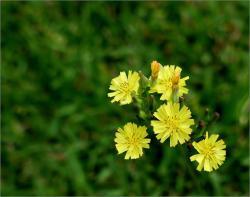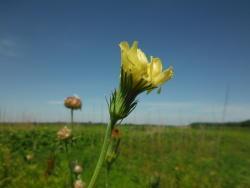This website swbiodiversity[dot]org/seinet/taxa/index.php?taxauthid=1&taxon=6243&cl=2885
Says this of Pyrrhopappus pauciflorus (which apparently is also called Pyrrhopappus Multicaulis), none of which can I interpret:
"Annuals (sometimes persisting), 5-40(-80+) cm. Stems seldom, if ever, scapiform, branching from bases and/or distally, usually sparsely to densely pilosulous proximally, sometimes glabrous. Cauline leaves 1-3(-5+), proximal mostly oblanceolate to lance-olate, margins usually pinnately lobed, sometimes dentate or entire, distal ± lanceolate, margins usually pinnately (3-)5-7(-9+)-lobed. Heads (1-)3-7+ in loose, corymbiform arrays. Calyculi: bractlets 8-13 in 1-2 series, deltate to subulate, 3-5(-6) mm. Involucres ± campanulate to cylindric, 16-22 mm. Phyllaries 13-21. Florets 50-60; anthers 3.5 mm (pollen equatorial diameters 43-46 µm). Cypselae: bodies reddish brown, 4-5 mm, beaks 7-9 mm; pappi 7-9(-10) mm. 2n = 12. Flowering (Feb-)Apr-May. Disturbed sites, prairies, clay soils; 10-500 m; Tex.; Mexico (Coahuila, Nuevo León, Tamaulipas). Some specimens of Pyrrhopappus from the Panhandle of Texas and from New Mexico are intermediate for traits used here to distinguish P. pauciflorus and P. rothrockii"
I know what annuals and stems are but that's about it. I tried to look up the meaning of involucre and is was defined as: "one or more whorls of bracts situated below and close to a flower, flower cluster, or fruit"
Since I didn't know what whorls or bracts were, I gave up.

